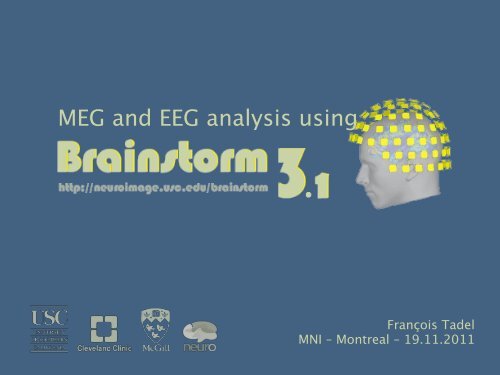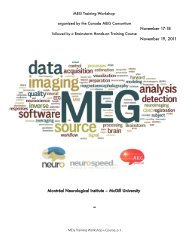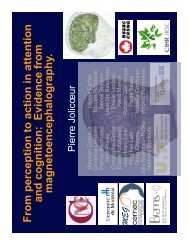MEG source reconstruction with Brainstorm - Canada MEG ...
MEG source reconstruction with Brainstorm - Canada MEG ...
MEG source reconstruction with Brainstorm - Canada MEG ...
You also want an ePaper? Increase the reach of your titles
YUMPU automatically turns print PDFs into web optimized ePapers that Google loves.
<strong>MEG</strong> and EEG analysis using<br />
François Tadel<br />
MNI – Montreal – 19.11.2011
Foretaste Graphical interface<br />
2
Foretaste Scripting environment<br />
• Rapid selection of files and processes to apply<br />
• Automatic generation of Matlab scripts (everything is<br />
scriptable)<br />
• Plug-in structure: easy to add custom processes<br />
3
<strong>Brainstorm</strong> is…<br />
• A free and open-<strong>source</strong> application<br />
(GPL)<br />
• Matlab & Java: Platform-independent<br />
• Designed for Matlab environment<br />
• Stand-alone version also available<br />
• Interface-based: click, drag, drop<br />
• No Matlab experience required<br />
• Daily updates of the software<br />
4
A bit of history<br />
• 10 years of research and development<br />
• Active collaboration between multiple<br />
groups<br />
(France, USA, and now <strong>Canada</strong>)<br />
• New interface released in 2009<br />
• Over 6000 user accounts<br />
• Hundreds of active users in 60<br />
countries<br />
5
Workflow<br />
Anatomy<br />
Sensors<br />
EEG/<strong>MEG</strong><br />
Coregistration<br />
Source<br />
estimation<br />
Analys<br />
is<br />
6
Database<br />
• Three levels:<br />
– Protocol<br />
– Subject<br />
– Condition<br />
• Popup menus<br />
• All files saved in<br />
Matlab .mat<br />
• Same architecture on the<br />
disk 7
Anatomy<br />
• T1-MRI volume<br />
• Surfaces extracted <strong>with</strong> a dedicated software:<br />
BrainVISA, FreeSurfer, BrainSuite<br />
8
Co-registration <strong>MEG</strong> / MRI (1)<br />
• Basic estimation based on three points<br />
(NAS,LPA,RPA)<br />
– MRI: Marked in the volume <strong>with</strong> the MRI<br />
Viewer<br />
– <strong>MEG</strong>: Obtained <strong>with</strong> a tracking system<br />
(Polhemus)<br />
9
Co-registration <strong>MEG</strong> / MRI (2)<br />
• Automatic adjustment based on head shape<br />
– Trying to fit the head points (digitized <strong>with</strong> the<br />
Polhemus) <strong>with</strong> the head surface (from the MRI)<br />
• Final registration must be checked manually<br />
10
Continuous recordings<br />
• Review continuous file<br />
• Supports most common EEG/<strong>MEG</strong> file formats<br />
• Edit markers, display 2D projections and <strong>source</strong>s<br />
11
Pre-processing Filtering<br />
• Frequency filtering<br />
Not filtered<br />
Low-pass<br />
40Hz<br />
12
Pre-processing Cleaning<br />
• Artifact detection and removal:<br />
– heartbeats, eye blinks, movements, …<br />
ECG<br />
EOG<br />
ECG<br />
EOG<br />
13
Pre-processing Cleaning<br />
• Two categories of artifacts:<br />
– Well defined, reproducible, short, frequent:<br />
• Heartbeats, eye blinks, stimulator<br />
• Unavoidable and frequent: we cannot just<br />
ignore them<br />
• Can be modeled and removed from the signal<br />
efficiently<br />
– All the other events that can alter the<br />
recordings:<br />
• Movements, building vibrations, metro<br />
nearby…<br />
• Too complex or not repeated enough to be<br />
modeled 14
Pre-processing Cleaning<br />
• Example of the cardiac artifact<br />
=> Computation of a Signal-Space Projection<br />
(SSP)<br />
Original<br />
SSP<br />
15
Pre-processing <br />
• Epoching: extraction of small blocks of<br />
recordings around an event of interest<br />
(stimulus, spike…)<br />
16
Pre-processing <br />
• Averaging all the trials: Reveals the features<br />
of the signals that are locked in time to a<br />
given event<br />
=> ERF: Evoked-response field (or “eventrelated”)<br />
=> ERP in EEG<br />
17
Source estimation<br />
• Forward model = head model<br />
Sources => Sensors<br />
• Inverse model: Minimum norm estimates<br />
Sensors => Sources<br />
• Source space: cortex surface (or full head<br />
volume)<br />
Forward<br />
Inverse<br />
18
Minmum Norm <br />
Noise covariance<br />
• Inverse model (minimum norm estimates)<br />
requires an estimation of the level of noise<br />
on the sensors<br />
• Computation of the noise covariance matrix<br />
= covariance of the segments of recordings<br />
that do not contain any “meaningful” data<br />
• Typically: empty room measures, pre-stim<br />
baseline<br />
19
Regions of interest<br />
• Regions of interest at cortical level (scouts)<br />
= Subset of a few dipoles in the brain<br />
= Group of vertices of the cortex surface<br />
20
Post-processing<br />
•Noise normalization (z-score)<br />
•Time-frequency analysis<br />
•Group analysis:<br />
– Anatomical registration and normalization<br />
– Statistical inference<br />
21
Time-frequency<br />
22
Group analysis <br />
<br />
• Registration of individual brains on a<br />
template<br />
Subject 1<br />
Subject 2<br />
G r o u p<br />
analysis<br />
Average<br />
Contrast<br />
…<br />
Individual<br />
anatomy<br />
Standard<br />
anatomy<br />
23
Group analysis <br />
• Contrasts between subjects or conditions<br />
• Statistical analysis: z-score, t-test<br />
• Quick extraction of measures from complex<br />
paradigms<br />
=> Export to: R, Excel, Statistica, SPSS,<br />
Matlab…<br />
24
Support<br />
• <strong>Brainstorm</strong> online tutorials and forum:<br />
• Visit us: Bi-weekly <strong>MEG</strong> / <strong>Brainstorm</strong> walk-in<br />
clinic<br />
=> Every other Friday at the Neuro<br />
25
Sample data <br />
• Median nerve stimulation<br />
– Random electric stimulation of both arms<br />
– ~ 100 trials per arm<br />
– Acquisition at 1200 Hz<br />
– <strong>MEG</strong> + EOG + ECG + STIM + … = 302<br />
channels<br />
– 6 minutes of recordings, 500 Mb<br />
26
Sample data Acquisition<br />
Polhemus<br />
Stim<br />
3D points<br />
Stimulation<br />
computer<br />
<strong>MEG</strong><br />
Acquisition<br />
computer<br />
27
Sample data To-<br />
• Create a protocol, <strong>with</strong> one subject<br />
• Anatomy<br />
– Import the MRI, define the fiducials<br />
– Import the surfaces<br />
– 3D display<br />
• Recordings:<br />
– Review the continuous file<br />
– Mark cardiac peaks + eye blinks<br />
– Remove the ocular artifacts (SSP)<br />
28
Sample data To-<br />
• Recordings:<br />
– Import trials: [-150, +400] ms around each<br />
stimulus<br />
– Average the trials (left and right)<br />
– Explore the average at the sensor level<br />
• Source estimation:<br />
– Computation of a head model<br />
– Computation of the noise covariance<br />
matrix<br />
– Computation of the <strong>source</strong>s time series<br />
– Review visually the results for left and right<br />
stim<br />
29




